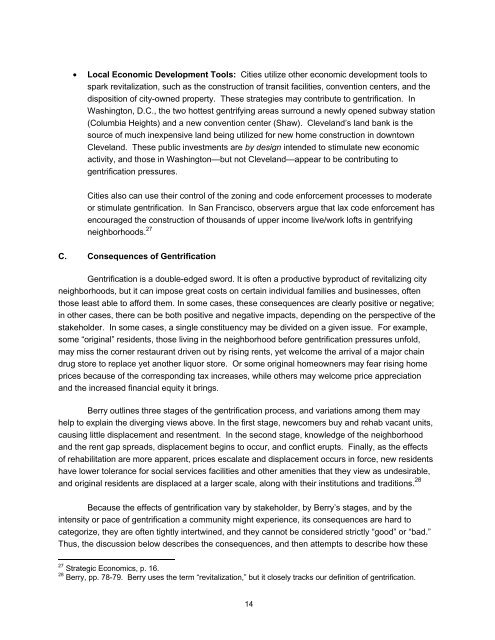gentrification
gentrification
gentrification
Create successful ePaper yourself
Turn your PDF publications into a flip-book with our unique Google optimized e-Paper software.
• Local Economic Development Tools: Cities utilize other economic development tools tospark revitalization, such as the construction of transit facilities, convention centers, and thedisposition of city-owned property. These strategies may contribute to <strong>gentrification</strong>. InWashington, D.C., the two hottest gentrifying areas surround a newly opened subway station(Columbia Heights) and a new convention center (Shaw). Cleveland’s land bank is thesource of much inexpensive land being utilized for new home construction in downtownCleveland. These public investments are by design intended to stimulate new economicactivity, and those in Washington—but not Cleveland—appear to be contributing to<strong>gentrification</strong> pressures.Cities also can use their control of the zoning and code enforcement processes to moderateor stimulate <strong>gentrification</strong>. In San Francisco, observers argue that lax code enforcement hasencouraged the construction of thousands of upper income live/work lofts in gentrifyingneighborhoods. 27C. Consequences of GentrificationGentrification is a double-edged sword. It is often a productive byproduct of revitalizing cityneighborhoods, but it can impose great costs on certain individual families and businesses, oftenthose least able to afford them. In some cases, these consequences are clearly positive or negative;in other cases, there can be both positive and negative impacts, depending on the perspective of thestakeholder. In some cases, a single constituency may be divided on a given issue. For example,some “original” residents, those living in the neighborhood before <strong>gentrification</strong> pressures unfold,may miss the corner restaurant driven out by rising rents, yet welcome the arrival of a major chaindrug store to replace yet another liquor store. Or some original homeowners may fear rising homeprices because of the corresponding tax increases, while others may welcome price appreciationand the increased financial equity it brings.Berry outlines three stages of the <strong>gentrification</strong> process, and variations among them mayhelp to explain the diverging views above. In the first stage, newcomers buy and rehab vacant units,causing little displacement and resentment. In the second stage, knowledge of the neighborhoodand the rent gap spreads, displacement begins to occur, and conflict erupts. Finally, as the effectsof rehabilitation are more apparent, prices escalate and displacement occurs in force, new residentshave lower tolerance for social services facilities and other amenities that they view as undesirable,and original residents are displaced at a larger scale, along with their institutions and traditions. 28Because the effects of <strong>gentrification</strong> vary by stakeholder, by Berry’s stages, and by theintensity or pace of <strong>gentrification</strong> a community might experience, its consequences are hard tocategorize, they are often tightly intertwined, and they cannot be considered strictly “good” or “bad.”Thus, the discussion below describes the consequences, and then attempts to describe how these27 Strategic Economics, p. 16.28 Berry, pp. 78-79. Berry uses the term “revitalization,” but it closely tracks our definition of <strong>gentrification</strong>.14


